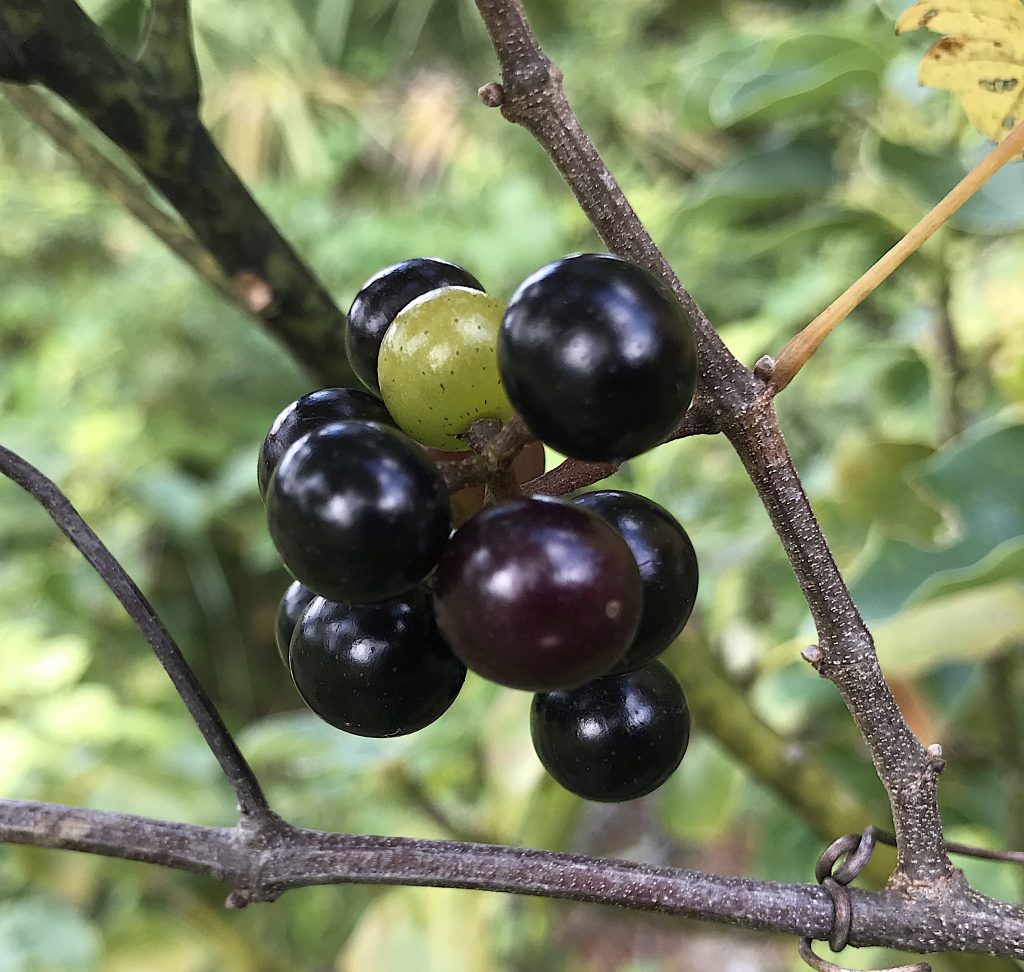
Wild Grapes are coming into season a little early this year. This single-tendril species tends to be high in acid. You can read about them here
Is mother nature getting ahead of herself? When a particular wild species comes into season varies from location to location, season to season. Since my childhood I have noticed wild grapes are usually in season (which to me means edible) in September, this was true in Maine and Florida. Last weekend we found so many ripe grapes the foraging classes didn’t want to eat anymore. Most of them were single tendril grapes (Vitis munsoniana) in Melbourne and Cassadega but a few forked tendril grapes as wel (vitis aestavalis). Keep your eyes out. I expect to find some in Ft. Pierce this weekend along with tallow plums.
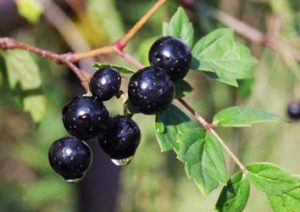
Peppervine is an iffy edible. Photo by Green Deane
Also putting on black fruit now is the controversial Pepper Vine, Ampelopsis arborea. It is closely related to the edible grape but also closely related to the toxic Virginia Creeper. It’s one of those plants that some folks say is definitely toxic and others say definitely edible. My personal experience is that it is not edible but I know some credible foragers who say they have eating the ripe berries for a long time with no issue. No doubt the problem has to do with annual calcium oxalate production. In small amounts it’s tolerable. In higher concentrations it can cause skin problems or internally upset digestion. Pepper Vine (so-called because the fruit can give a pepper-like burn) apparently can make little to a lot of the chemical each year, varying greatly. Another possibility is method of preparation. Some people juice the berries and let the juice sit in the refrigerator which allows the acid to precipitate. The juice is then carefully decanted through two coffee filters and used. Not for me but if you do said proceed with caution. The other caution is that Pepper Vine and Wild Grapes can grow intertwined and you can get some Pepper Vine fruit in with your grapes. This also can happen with Virginia Creeper. Pick your grapes carefully.
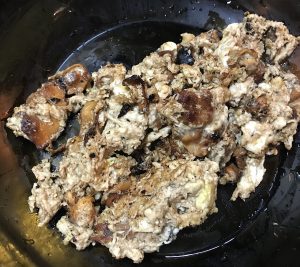
Eggs scrambled wiht chanterelles, ghee and cream.
Mushrooming this week was hopeful. In Cassadaga we saw a few good boletes (Gyroporus smithii aka G. castaneus) and some too-peppery-to-eat milk caps. However, after class I went to my favored location in Lake Mary and found enough chanterelles for three breakfasts. There were also a few milk caps, Peaches & Cream (lactifuluus hygrophproides) Corrugated cap milky (Lactifluus corrugis) and the buff fishy milky, lactifluus luteolus. Oh and one Laetiporus persicinus, White Chicken of the Wood, which is probably not a Laetiporus and not as choice as its other namesakes. For three mornings in a row I fried the chanterelles in ghee, reduced in cream, and then mixed with eggs for scrambling. If you are going to use the Laetiporus persicinus, mix it with strong flavors. I make jerky out of it. Last May the late Dasheill Scofield wrote he cooked it with cube steak, asparagus, red wine vinegar, kalamata olives, with a blue cheese sauce.
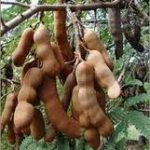
Tamarind is a popular flavoring.
Plant beggars can’t be choosy? When Paul Dreher was given the task of landscaping the 100 acres that is now the park bearing his name in West Palm Beach, he had no budget. Dreher took hand outs, donations, seeds and scrounged debris piles. This might account for some of the more unusual plantings in the park. At the north entrance of the park, for example, there are 22 Tamarind trees at the traffic circle (and at least two more on the south end of the park.) If you were given 22 Tamarind trees what would you do with them? Tamarindus indica, is from warm Africa. Today it is commonly found in South Asia and Mexico. India is the world largest producer of Tamarind. Its nutritious pods are consumed raw and cooked and is one of the current flavor darling of many avant-garde restaurants. The flavor is distinctive, both sweet and sour( from tartaric acid.) The tree itself is slow-growing and long-lived. Without its annual pods the tree can easily hide, moderate in size, not too distinct. Interestingly few trees in the greater pea family are edible with the Tamarind and the Eastern Red Bud being two exceptions. If you want to see 22 of them…
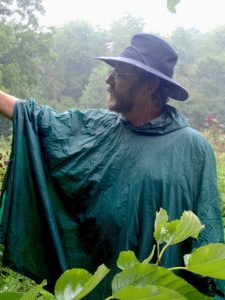
Classes are held rain or shine or cold. (Hurricanes are an exception.) Photo by Kelly Fagan.
Foraging classes this weekend touch upon both coasts, Largo to Ft. Pierce.
Saturday, July 23rd, Eagle Park Lake, 1800 Keene Road, Largo, FL 33771. Meet at the pavilion near the dog park. 9 a.m.
Sunday, July 24th, George LeStrange Preserve, 4911 Ralls Road, Fort Pierce, FL, 34981. 9 a.m.
Saturday, July 30th, Mead Garden: 1500 S. Denning Dr., Winter Park, FL 32789. Meet at the bathrooms. 9 a.m.
Sunday, July 31th, Dreher Park, 1200 Southern Blvd., West Palm Beach, 33405. Meet just north of the science center 9 a.m.
For more information, the pre-pay for a class, or sign up go here.
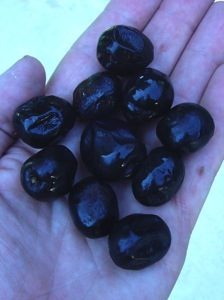
Eating Saw Palmetto fruit is a challenge.
As we are approaching August Saw Palmetto Berries are turning from green to gold. In another month they will be black and edible (so to speak.) Many folks find the flavor of Saw Palmetto berries revolting. I am not sure if they are an “acquired” taste or a tolerated one. You will either be able to eat them or not. Basically they tastes like vomit. To be a little more gracious they taste like intense blue cheese with some burning hot pepper tossed in. Once you get used to them they are… endurable. But if you were hungry you would crave them in that they have all the essential amino acids humans need to be healthy. They are good for you even if you don’t like them. As with some fruit — Durian for example — the smell is enough to dissuade many people from eating them. Saw Palmetto berries will be ripening into September thus you have plenty of time to try one.
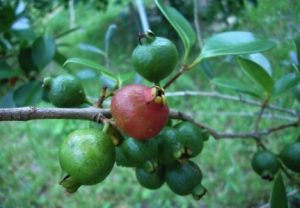
You want pink and green strawberry guava. Photo by Green Deane
Also just beginning to fruit is a species that is very invasive in some areas: The Strawberry Guava. . I had one in my yard for about 15 years. Not only are the fruit edible but the dried leaves can be made into a passable tea. One does, however, need to know a little about the species to make the most of the fruit. It’s a little smaller than a ping-pong ball, has tough seeds, and starts out green and hard. As it ripens and softens it will get shades of pink, yellow and red and eventually become dark red and soft, hence the name “Strawberry Guava.” The fruit is tart and sweet, more tart when young, more sweet when older. Despite the name I never tasted a strawberry flavor in any of the fruit. The problem is unless you spray the tree with insecticides the ripe fruit will be full of fly larvae (which you can also view as free protein.) When the fruit is just starting to turn from green to red the rind is too hard for the flies to lay eggs through. But by the time they are soft and ripe they are prime breeding ground. Thus you have a choice, slightly ripe and tart but bug free, or, very ripe and sweet and squirming. To read more about the Strawberry Guava go here.

You get the USB, not the key.
Changing foraging videos: As my WordPress pages are being updated the video set will go away. They are the same videos I have on You Tube. Some people like to have a separate copy. The DVD format, however, is becoming outdated. Those 135 videos plus 36 more are now available on a USB drive. While the videos were played from the DVDs the videos on the USB have to be copied to your computer to play. They are MP4 files. The 171-video USB is $99. If you make a $99 “donation” using the link at the bottom of this page or here, that order form provides me with your address, the amount — $99 — tells me it is not a donation and is for the USB.

Green Deane Forum
Want to identify a plant? Perhaps you’re looking for a foraging reference? You might have a UFO, an Unidentified Flowering Object, you want identified. On the Green Deane Forum we — including Green Deane and others from around the world — chat about foraging all year. And it’s not just about warm-weather plants or just North American flora. Many nations share common weeds so there’s a lot to talk. There’s also more than weeds. The reference section has information for foraging around the world. There are also articles on food preservation, and forgotten skills from making bows to fermenting food.
This is weekly newsletter #516, If you want to subscribe to this free newsletter you can find the sign-up form in the menu at the top of the page.
To donate to the Green Deane Newsletter click here.


Hello Green Dean
I am questioning if the leaves of rivina are safe to eat.
Thank you
No.